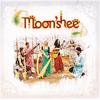
MOONSHEE Moonshee
Park Records PRKCD114
This debut album from young six-piece band Moonshee is a successful fusion of mostly traditional English and Irish songs and tunes with the music of the Indian sub continent. Fusion needs to be handled with care, or violent fission can follow. Moonshee manage this easily through the delicate, serene musicianship of Amy McAllister (harp and violin), Rachel Button (violin), Joelle Barker (cajon drum), Lisa Fitzgibbon (guitar), Mitel Purohit (Indian percussion) and Jonathan Mayer (sitar). The music is all bathtime buoyancy, with bubbles of delight.
The opening song is Bold Riley, taking us outward bound for the Bengal Bay. The closing song underlines the Eastern influence of Tomorrow Never Knows, from the Beatles’ Revolver album. In between, familiar songs like Fair And Tender Ladies, I Live Not Where I Love, Polly Vaughan, and Water Is Wide are given new twists. Love And Grace and Moonshee are self-written songs (I think) which point to their underlying interest in Indian culture and religions. The bravest songs are those which include verses in Hindi from guest singer Japjit Kaur. Other guests include Rose Doonan, Benji Kirkpatrick, John Spiers and Giles Lewin. The two tunes are both Irish: Eleanor Plunkett and The Concertina Reel, which for some reason they call Cortina Reel Mk III.
Here’s the grumpy bit. I hope that the band can get a grip on crediting next time around. The liner notes attribute all the traditional songs and tunes to the band or to their guests. Trad. Arr, those two truncated words which mean so much, are nowhere to be seen. Different cultures are given respect on this album. Respect should be given also to the anonymous originators of most of the band’s material.
Tony Hendry
| Buy
this CD online from The Listening Post The Listening Post is the CD mailorder service of The Living Tradition magazine. This album was reviewed in Issue 91 of The Living Tradition magazine. |

